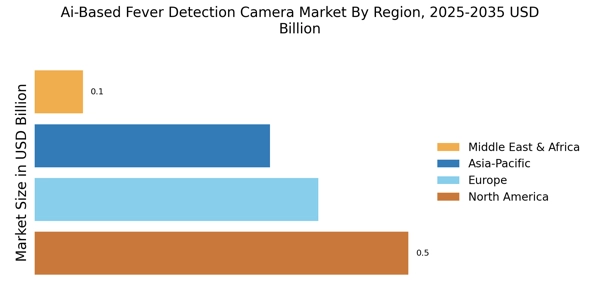Rising Health Awareness
The Ai-Based Fever Detection Camera Market is witnessing a surge in demand due to rising health awareness among the population. Individuals and organizations are increasingly prioritizing health monitoring, particularly in public spaces. This heightened awareness is reflected in the growing adoption of fever detection cameras in schools, offices, and transportation hubs. According to recent data, the market is expected to reach a valuation of several billion dollars by 2026, driven by the need for proactive health measures. Organizations are investing in these technologies to ensure the safety of employees and customers, thereby fostering a culture of health consciousness. This trend indicates a shift towards preventive healthcare, where early detection of potential health issues is becoming a standard practice.
Technological Advancements in AI
The Ai-Based Fever Detection Camera Market is experiencing rapid technological advancements, particularly in artificial intelligence and machine learning. These innovations enhance the accuracy and speed of fever detection, making these cameras more reliable in various settings. For instance, the integration of advanced algorithms allows for real-time data processing, which is crucial in environments such as airports and hospitals. The market is projected to grow significantly, with estimates suggesting a compound annual growth rate of over 20% in the coming years. This growth is driven by the increasing need for efficient health monitoring solutions, particularly in high-traffic areas where traditional methods may be inadequate. As technology continues to evolve, the capabilities of these cameras are likely to expand, further solidifying their role in public health surveillance.
Integration with Smart Infrastructure
The Ai-Based Fever Detection Camera Market is benefiting from the integration of fever detection cameras with smart infrastructure systems. As cities and organizations increasingly adopt smart technologies, the demand for seamless integration of health monitoring solutions is rising. This integration allows for enhanced data collection and analysis, enabling more effective health management strategies. For instance, fever detection cameras can be linked with building management systems to automate responses in case of detected fevers. The market is projected to expand as more entities recognize the value of interconnected systems, with estimates suggesting a growth rate of around 18% over the next few years. This trend indicates a shift towards holistic health monitoring solutions that leverage technology to improve public safety.
Government Initiatives and Regulations
The Ai-Based Fever Detection Camera Market is significantly influenced by government initiatives and regulations aimed at enhancing public health safety. Various governments are implementing policies that encourage the use of advanced health monitoring technologies in public spaces. For example, mandates for temperature screening in airports and public transport systems have led to increased adoption of fever detection cameras. This regulatory support is expected to drive market growth, with projections indicating a potential increase in market size by over 15% in the next few years. Furthermore, government funding for health technology initiatives is likely to bolster research and development in this sector, leading to more innovative solutions and wider applications of fever detection cameras.
Increased Investment in Health Technologies
The Ai-Based Fever Detection Camera Market is experiencing increased investment in health technologies, driven by both private and public sectors. Investors are recognizing the potential of fever detection cameras as essential tools for health monitoring in various environments. This influx of capital is facilitating research and development, leading to more advanced and efficient products entering the market. Recent reports indicate that investment in health technology is expected to grow by over 25% annually, reflecting a strong belief in the long-term viability of these solutions. As more companies enter the market, competition is likely to spur innovation, resulting in improved features and functionalities of fever detection cameras. This trend underscores the importance of continuous investment in health technologies to meet the evolving needs of society.


















Leave a Comment